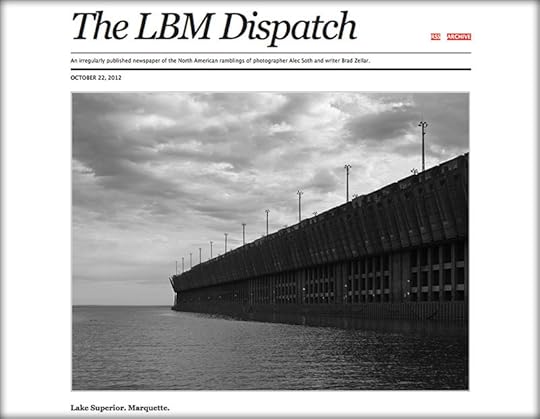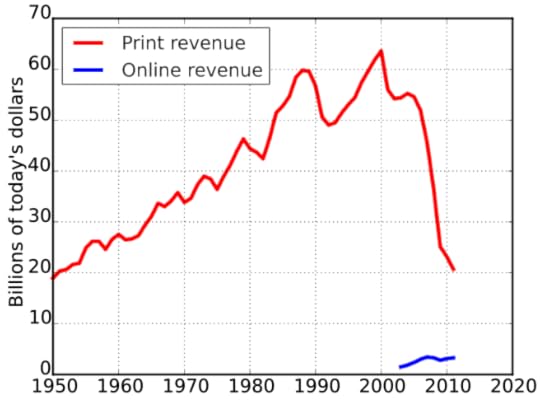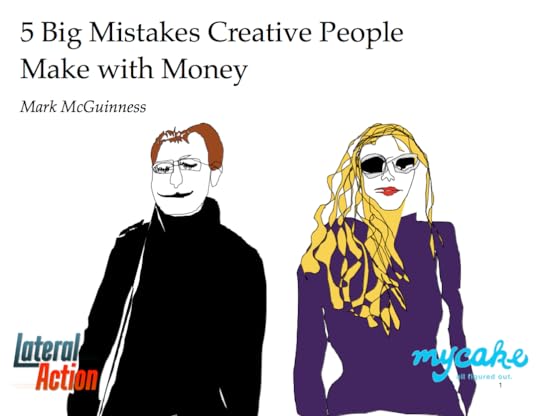Lassal's Blog, page 3
December 21, 2012
US Newspaper Advertising Revenue, Corrected For Inflation
If you are working directly and/or indirectly for the advertising world. This is a topic of interest.
You can find more information about the source here.
December 19, 2012
(I hope my professional photographer friends are going to read this and take it to heart – very many of them have Instagram accounts.)
People often shake their heads in disbelief when I tell them that I make a point in reading the TOCs that I have to “accept” for a service.
I copy&paste them, print them, read them with my marker in hand, and … if I do not like it, I do not sign/accept the contract.
Granted, it is a pain sometimes, because some companies are constantly changing their TOCs, and sometimes I simply do not seem to have the time to go through it. But then I simply postpone the installation of said update.
Why I do this? Because among other things and specially in the internet, I am wary of the word “FREE”. Nothing that comes from a company is really free. And the more they insist something is free without it making any business sense, the more it makes me suspicious.
Sometimes, ok, sometimes it is marketing for their service, a teaser. Some publishers do this by giving away the first book of a series for little or no money, hoping that a reader, if he likes the first part, will come back and pay for the rest. I have no problem with this approach, in fact, it is something I will be doing myself. It is a valid approach if it is openly done. I would say, it is a win-win situation.
There are a variety of variations of this method, and, if it is transparent, and I can live with it, then … great! I love win-win situations. Sometimes though, things look too good to be true. And then, usually they are not true.
And sometimes, there is greed.
In its first big policy shift since Facebook bought the photo-sharing site, Instagram claims the right to sell users’ photos without payment or notification. Oh, and there’s no way to opt out.
. . .
The new intellectual property policy, which takes effect on January 16, comes three months after Facebook completed its acquisition of the popular photo-sharing site. Unless Instagram users delete their accounts before the January deadline, they cannot opt out.
. . .
Under the new policy, Facebook claims the perpetual right to license all public Instagram photos to companies or any other organization, including for advertising purposes, which would effectively transform the Web site into the world’s largest stock photo agency. One irked Twitter user quipped that “Instagram is now the new iStockPhoto, except they won’t have to pay youanything to use your images.”
“It’s asking people to agree to unspecified future commercial use of their photos,” says Kurt Opsahl, a senior staff attorney at the Electronic Frontier Foundation. “That makes it challenging for someone to give informed consent to that deal.”
. . .
Facebook’s new rights to sell Instagram users’ photos come from two additions to its terms of use policy. One section deletes the current phrase “limited license” and, by inserting the words “transferable” and “sub-licensable,” allows Facebook to license users’ photos to any other organization.
A second section allows Facebook to charge money. It says that “a business or other entity may pay us to display your… photos… in connection with paid or sponsored content or promotions, without any compensation to you.” That language does not exist in the current terms of use.
. . .
Another unusual addition to Instagram’s new policy appears to immunize it from liability, such as class action lawsuits, if it makes supposedly private photos public. The language stresses, twice in the same paragraph, that “we will not be liable for any use or disclosure of content” and “Instagram will not be liable for any use or disclosure of any content you provide.”
Read the whole article at CNet
I never trusted Facebook. Yes, I do have accounts there for both myself and for Fingeralphabet and LegendarMedia. Unfortunately I have yet to find a better way to communicate with an assorted group of people I know. But believe me when I say that I read EVERY single bit of their TOC-updates. And I know just when I will be leaving the platform. (I have been reducing my presence there anyway)
And I never trusted Instagram enough to use it in the first place.
Oh, and by the way, I do not seem to be the only one to read the TOC. There was a huge outrage yesterday, including many well know people from the blogosphere who wowed to delete their accounts. Results? Instagram/Facebook released a statement about “misunderstandings” (yeah, yeah), and that they would “remove” the language that caused a user revolt over the last day.
Like with any contract, be careful what you sign. You generally cannot “unsign” later.
And yes, if you are an adult, then it is your responsibility. No one is holding a gun to your head.
I hope my professional photographer friends are going to read this and take it to heart – very many of them have Instagram accounts.
December 17, 2012
Habibi – A Story of Love and Hope (for adults)
While I believe in God I have never been attracted to specific religions and I usually avoid the topic altogether. While I love my books of science and physics, I am wary of religious texts of any (!) kind. While I pray, I do not pray in a church – even though I am a member of one.
I write this to frame this book’s recommendation. Because it deals with religion(s). It also deals with race issues, gender issues, financial issues, ecological issues, cultural issue – human issues, humans.
Mostly, it deals with love. With the power of it.
It is a love story of the kind, that tells us that despite of all that we are seeing around us, there still is hope. It is a love story of the kind, that tells us that despite of all the darkness, there still is light. Even if we have to dig deep inside of ourselves to find it.
It tells us that while humans are a force of destruction, we are also a force of love – or at least that we have the potential for it.
I cannot judge the “correctness” of the included religious parts, apart from the fact that they did not make me feel uneasy. Quite the contrary. It is the way this story is woven – using images, words, letters, empty spaces – that got to me. It is about all of us, I would say, regardless of religion. But it is about belief, it is about hope, it is about love, and the importance of it. While it points out how superficial differences are used to separate and control people, it also offers the solution.
The substories that are intertwined in this book – a book about storytelling – are stories that I know from the Bible just as other stories that I had never heard of before. Beautiful, arresting stories. Dark, sad stories.
Habibi is not for children. It is a gift for adults. And – I would dare to say – a gift for our souls.
If you celebrate Christmas, it might be a fitting present to someone you love. If you celebrate something other than Christmas, it might be a fitting present to someone you love all the same. Other than most religions, this book does not require a set belief. That is how I see it from my vantage point. And that is why I love this book and am urging you to have a look at it.
I wish I could do something this magnificent. But I cannot. Instead, someone else did it. And I am very grateful!
The Blurb:
Sprawling across an epic landscape of deserts, harems, and modern industrial clutter, Habibi tells the tale of Dodola and Zam, refugee child slaves bound to each other by chance, by circumstances, and by the love that grows between them. At once contemporary and timeless, Habibi gives us a love story of astounding resonance: a parable about our relationship to the natural world, the cultural divide between the first and third worlds, the common heritage of Christianity and Islam, and, most potently, the magic of storytelling.
Oh and it won a couple of prizes … (Eisner, Harey, Ingnatz Awards for Best Graphic Novel and Best Cartoonist)
Well deserved in my oppinion.
Disclosure of Material Connection: Some of the links in the post above are “affiliate links.” This means if you click on the link and purchase the item, I will receive an affiliate commission. Regardless, I only recommend products or services I use personally and believe will add value to my readers. I am disclosing this in accordance with the Federal Trade Commission’s 16 CFR, Part 255: “Guides Concerning the Use of Endorsements and Testimonials in Advertising.”
December 16, 2012
5 Big Mistakes Creative People Make with Money
I just found this gem from Mark McGuinness during my morning coffee break. You cannot imagine my joy when I saw that it was a PDF I am allowed to share with others.
Why? Two reasons:
I see people all over the place doing these mistakes.
Mark McGuinness wraps them in a story, which makes it easier to digest.
Click the image above or click HERE to download the PDF.
And go here for more information on Mark McGuinness.
Disclosure of Material Connection: I have not received any compensation for writing this post. I have no material connection to the brands, products, or services that I have mentioned. I am disclosing this in accordance with the Federal Trade Commission’s 16 CFR, Part 255: “Guides Concerning the Use of Endorsements and Testimonials in Advertising.”
December 14, 2012
Security Measures for Your Website & Your Data
It is not enough to have a nice looking website. It also has to be safe for your clients to visit it.
Now you might think that you are only a small business and cannot afford the security measures, but there are actually services around that are cheap and can help you with this.
It is your responsibility not to spread malware to your clients.
Do a quick online research on your hosting service. Some are more vulnerable than others and often it will only cost you a few EUR/month to get a more reliable and secure service.
Keep the software on your computer system up to date. Most software allows you to run automated updates, which is convenient for most of us who are no experts.
Check out if a monitoring-services might be something for you. These are services (like Initiative-S in Germany, which is financed by the government) where you can register your website for a free external check and constant monitoring. If they find an infection, they will not only let you know about it, but they will also tell you how to fix the problem.
For Germany / German speakers: you might also be interested in BürgerCERT, a governmental project where you can register for several kinds of internet security related newsletters (technical warnings, security update informations etc). I registered several years ago when I first heard of it and it was (still is) a blessing. Before that I was constantly worried of missing something important – now I just have to go through the newsletters to know the vital stuff. VERY CONVENIENT!
You will probably find this kind of services in your language, too. Internet Security problems are mostly a global issue.
Remember, just because you are a small business, it does not mean that you will not be targeted. Sometimes things just happen. Attacks spread. And seriously, when you have to do a lot of research online, like hunting for pictures, then chances are high that you will run across more than what you are looking for. With Apple increasing its market share, it is no longer safe to assume that because you have a MAC this topic does not affect you (and your clients).
Secure Your/Your Client’s Data
Regardless if you are working on a PC or on a MAC, set up a crash-proof backup system. It is inevitable, malware or no malware, that sooner or later something will happen that will endanger your data — be it hardware failure, software failure or even user failure. Most likely it will happen in the least convenient moment, too, shortly before a deadline or similar.
I myself am not a technical expert, but I can tell you what I am doing.
I have more than one business. And I have a separate harddrive in my MAC for each one of them. And one harddrive for my system. If one harddrive fails, I just have to worry about one set of data.
I have an external backup drive for my system, which I backup with SuperDuper. I have this scheduled in my calendar and do it manually. I could automate it via SuperDuper, but I do not want my system backup in a vulnerable position (it is my backup after all), so I do not have it powered up all the time and I do not have it plugged into my main system unless I am backing up. Still, I do a minimum backup of once a week. If I am installing a lot of things and much is going on, I’ll do it more often.
I have an external RAID system for my data, too. Two mirrored disks. So if one fails, I still have the other. TimeMachine comes free with every Mac and that is what I am using for this backup. You can choose the source (in my case everything but the system) and the whole setup is completely painless – it also is completely automated.
While working on projects, I generally use the fact that I use separate harddrives for my businesses and make quick additional backups of the project data onto the other drives. So if I accidentaly overwrite a file because I forgot to rename a new version (this likes to happen to me in a night session), I just recover it quickly from one of my other harddrives. I would hate to use TimeMachine for this because if I do not notice my mistake right away, I might lose everything I have done in between. (Yes, there are ways around this, but simply getting the lost file from another harddrive, is quicker and less complicated – we are talking about stressful nightsessions here, and the less complicated and the faster a solution is, the better)
Apart from the constant TimeMachine backups I have separate harddrives, where I archive finished projects. I store these harddrives somewhere else altogether.
Stay safe.
Keep your clients safe.
December 7, 2012
Fairy Tale Weather
This image might be from 2010, but I could practically make the same picture outside right now – if it were not night.
The 3 Most Important Elements of a Professional Website
Ok, in this post I am mainly talking about illustrators and photographers who want to work for commercial agencies. Not only do I know the situation in this area, but I also got a lot of very specific feedback from the artbuyings I am used to work with.
If you are not an illustrator or photographer but you understand the basic thinking terms, I am sure you can come with working guidelines for your very own specific situation. It is all rooted in common sense. It is all wrapped around your client’s needs.
Many photographers/illustrators/designers who want to work for the creative industry are making a lot of wrong assumptions about websites and online portfolios. The biggest one being, that they do not need any of it.
Yes. You read this one correctly: I do know professional illustrators who have been working for this industry forever and who do NOT have a proper website. When I ask them why, I get a response along the lines of “I have been in this business for x years and I have never needed one, so why would I need one now?” And shortly thereafter they are wondering aloud, why “all of the sudden” they are getting less and less job offers from their old clients. There might obviously be different kinds of reasons for this development, things that are not under your control.
Work on those things – like your website – that ARE under your control!
You have to remember, that even if you are working for the same companies for long periods of time, the positions inside of the company might change, or the people holding specific positions change. So even if you think the artbuying of your favorite client’s company must know your work by heart, the new people in that department actually might not.
Young creatives today usually grow up having a website and a blog and Twitter and Facebook and whatever else. The younger generation is used to have an online presence. Their problem often is to get the priorities right.
First of all, most of the times it will be better for you to keep a separate business website. And this not only because you can deduct business expenses from your taxes (I am not a tax accountant, and these things work differently from state to state and country to country, so please check this with your local experts).
What I am mainly referring to is that I cannot think of a situation, where it would not look unprofessional when you clients were confronted with your family issues or having to wade through the results of your last party escapades.
If you want to be taken seriously and be given the responsibility of doing an assignment, you should behave professionally. Nobody cares what you do in your free time, as long as you do your job correctly. You could have 3 noses and your eyes on your forearms – as long as you do your job correctly, nobody really cares.
(I am not saying you should not be nice and interested in people and doing a little smalltalk – we are all people after all, just keep it in check and on a friendly professional level)
Mostly, what I am aiming at is, again, that you need to think about the workflow of your clients and how you’d fit in there the best way possible without disrupting it. You do not want them to have to go out of their way to be able to look at your work online. If you do, you better be really sought after, otherwise what will happen is simply that: nothing.
The good news is, that you do not need much to have that basic website with your portfolio that will be easy to use for ArtBuyings and editors. Neither will you need to spend thousands of EUR/USD (or whatever your currency) on it. Not only can you get most of the things you will need for free (or almost), you will also not need to be an expert to implement them.
So, how would an editor or an artbuyer normally walk through your website? What are the questions they would be trying to answer?
Is there something of interest in there for us or our clients?
>> Let’s have a look at the PORTFOLIO!
The work would be a fit, but can I trust that this creative person behaves professionally? Who else has s/he worked for?
>> Let’s check the CLIENTLIST!
I like the work and the person seems to be ok to work with, because the client list is impressive. So how do I contact him/her?
>> Let’s go to the CONTACT INFORMATION!
And that is the core of what you will need. Everything else is gravy.
Easy, right?! (smile)
Remember to put the portfolio right there smack on the homepage or at least accessible with 1 click. And if the portfolio contains a lot of material, then have some sensible way of sorting it.
Also try not to make the images all to small … Clients sometimes need to print things out for meetings. Include a copyright notice and the information about the copyright holder. Just in case someone downloads the picture while looking at 25 portfolios in a row, and later does not remember where he got it from. It happens. And remember: screenshots do not include metadata.
Sure, you can add some additional items, like a download page for PDFs with selected work samples. Some Clients specifically ask for these files for their internal workflow. I have to admit that I have never offered them, but if you have the time at hands now, you might want to do them and put them somewhere on the website, where they can be found and downloaded.
I always had a password protected client gallery, which has been extremely useful for me as I often work with international teams that are spread all over the place. Instead of sending everyone attachments and constantly having to make sure that everybody is on the same page and looking at the latest versions (consider time zones etc.), it was easier to give everyone a separate password and have it all sorted out in my gallery, where everyone could leave messages and little stars and whatnot to make their preferences or concerns or input clear to me and everybody else. My clients LOVED this! Up until 2 years ago. Since then I have not been using it anymore. Things change and now everybody wants to work with Dropbox or similar services. I am keeping my gallery, though, just in case.
You might also want to add a professional blog where you would be covering topics that could be of interest for your clients. And, if you often post relevant new material on your site, or go to meet clients on conferences and events, a newsletter might be interesting for them. Be sure to use a service that offers a double opt in, like Mailchimp (there are others).
Basically, as I said in the introduction. Identify your client’s needs and workflows. This will give you the best guidelines for your professional website.
And do not forget to include an imprint, a disclaimer and whatever is legally necessary in your country.
I am sure I forgot something … but feel free to ask in the comment section below.
Cheers!
December 6, 2012
Little Brown Mushroom and the LBM Dispatch
Everybody who was following my old blogs probably knows that I am a fan of Alec Soth’s Little Brown Mushroom.
Alec has a fairly new project, that he is working on with Brad Zellar: The LBM Dispatch.
The LBM Dispatch is an irregularly published newspaper of the North American ramblings of photographer Alec Soth and writer Brad Zellar.

screenshot: LBM dispatch
I just got the email with the new post on their blog, and I think that this belongs here, because Little Brown Mushroom stands for very fine storytelling indeed.
From October 20th through November 5th, Alec Soth and Brad Zellar will be on the road in Michigan, producing an election season version of the LBM Dispatch in one of the country’s most diverse and politically fascinating states. The trip –a rambling search for the state of the union in towns all over Michigan– will take them across the Upper Peninsula to the Mackinac Straits, and then downstate through the enormous territory of the Lower Peninsula, including stops in Saginaw, Flint, Detroit, Ann Arbor, Kalamazoo, and Grand Rapids. Follow along here: http://lbmdispatch.tumblr.com
You can preorder / subscribe to The LBM Dispatch here.
By the way, Alec, I am still waiting for that Trente Park book you once announced. I’d gladly preorder 5 books. I NEED to keep the standard of my christmas presents, after all, and I have many presents to buy. I am strongly counting on LBM.
December 4, 2012
Ira Glass on Storytelling
Ira Glass on Storytelling from David Shiyang Liu on Vimeo.
Regardless of what your creative ambitions are, this is a good advice to remember.
The text by Ira Glass above was extracted from a series of talks about the building blocks of a great story for “This American Life”. You can watch and listen to the rest of the talk by going to these videos:
Ira Glass on Storytelling, part 1 of 4
Ira Glass on Storytelling, part 2 of 4
Ira Glass on Storytelling, part 3 of 4
Ira Glass on Storytelling, part 4 of 4
And rememeber, even if he is referring to video or radio podcasts in particular, most of it is relevant for most creatives, regardless of if they are photographers, designer, illustrators, writers …
The overall principles of storytelling apply wildy throughout the creative sector. So even if you are not a video or radio broadcaster, there might be something in there for you to learn.
If you want even more advice from someone who knows what he is talking about (this time slanted a bit towards writers), check out this speech by Neil Gaiman.











